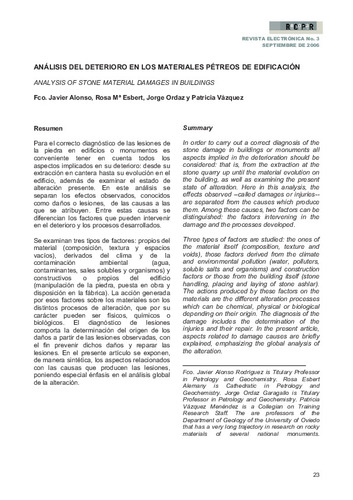Análisis del deterioro de los materiales pétreos de edificación
Other title:
Analysis of stone material damages in buildings
Publication date:
Citación:
Descripción física:
Abstract:
Para el correcto diagnóstico de las lesiones de la piedra en edificios o monumentos es conveniente tener en cuenta todos los aspectos implicados en su deterioro: desde su extracción en cantera hasta su evolución en el edificio, además de examinar el estado de alteración presente. En este análisis se separan los efectos observados, conocidos como daños o lesiones, de las causas a las que se atribuyen. Entre estas causas se diferencian los factores que pueden intervenir en el deterioro y los procesos desarrollados. Se examinan tres tipos de factores: propios del material (composición, textura y espacios vacíos), derivados del clima y de la contaminación ambiental (agua, contaminantes, sales solubles y organismos) y constructivos o propios del edificio (manipulación de la piedra, puesta en obra y disposición en la fábrica). La acción generada por esos factores sobre los materiales son los distintos procesos de alteración, que por su carácter pueden ser físicos, químicos o biológicos. El diagnóstico de lesiones comporta la determinación del origen de los daños a partir de las lesiones observadas, con el fin prevenir dichos daños y reparar las lesiones. En el presente artículo se exponen, de manera sintética, los aspectos relacionados con las causas que producen las lesiones, poniendo especial énfasis en el análisis global de la alteración.
Para el correcto diagnóstico de las lesiones de la piedra en edificios o monumentos es conveniente tener en cuenta todos los aspectos implicados en su deterioro: desde su extracción en cantera hasta su evolución en el edificio, además de examinar el estado de alteración presente. En este análisis se separan los efectos observados, conocidos como daños o lesiones, de las causas a las que se atribuyen. Entre estas causas se diferencian los factores que pueden intervenir en el deterioro y los procesos desarrollados. Se examinan tres tipos de factores: propios del material (composición, textura y espacios vacíos), derivados del clima y de la contaminación ambiental (agua, contaminantes, sales solubles y organismos) y constructivos o propios del edificio (manipulación de la piedra, puesta en obra y disposición en la fábrica). La acción generada por esos factores sobre los materiales son los distintos procesos de alteración, que por su carácter pueden ser físicos, químicos o biológicos. El diagnóstico de lesiones comporta la determinación del origen de los daños a partir de las lesiones observadas, con el fin prevenir dichos daños y reparar las lesiones. En el presente artículo se exponen, de manera sintética, los aspectos relacionados con las causas que producen las lesiones, poniendo especial énfasis en el análisis global de la alteración.
In order to carry out a correct diagnosis of the stone damage in buildings or monuments all aspects implied in the deterioration should be considered: that is, from the extraction at the stone quarry up until the material evolution on the building, as well as examining the present state of alteration. Here in this analysis, the effects observed --called damages or injuries-- are separated from the causes which produce them. Among these causes, two factors can be distinguished: the factors intervening in the damage and the processes developed. Three types of factors are studied: the ones of the material itself (composition, texture and voids), those factors derived from the climate and environmental pollution (water, polluters, soluble salts and organisms) and construction factors or those from the building itself (stone handling, placing and laying of stone ashlar). The actions produced by these factors on the materials are the different alteration processes which can be chemical, physical or biological depending on their origin. The diagnosis of the damage includes the determination of the injuries and their repair. In the present article, aspects related to damage causes are briefly explained, emphasizing the global analysis of the alteration.
In order to carry out a correct diagnosis of the stone damage in buildings or monuments all aspects implied in the deterioration should be considered: that is, from the extraction at the stone quarry up until the material evolution on the building, as well as examining the present state of alteration. Here in this analysis, the effects observed --called damages or injuries-- are separated from the causes which produce them. Among these causes, two factors can be distinguished: the factors intervening in the damage and the processes developed. Three types of factors are studied: the ones of the material itself (composition, texture and voids), those factors derived from the climate and environmental pollution (water, polluters, soluble salts and organisms) and construction factors or those from the building itself (stone handling, placing and laying of stone ashlar). The actions produced by these factors on the materials are the different alteration processes which can be chemical, physical or biological depending on their origin. The diagnosis of the damage includes the determination of the injuries and their repair. In the present article, aspects related to damage causes are briefly explained, emphasizing the global analysis of the alteration.
ISSN:
Files in this item




